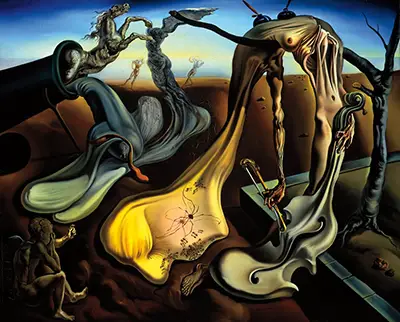This painting was originally titled "Soft Cello, Spider and Great Masturbator", and was later renamed by Dali into "Evening Spider Promises Hope". It was finished between 1939 and 1940, when Dali was about to deviate from his focus on single objects to veer into paintings more epic in scope and scale. The Spider of The Evening is marked with the same bright sky and land background that Dali used in his other 1940 painting The Sublime Moment, with blues and browns. But here they are muted and the foreground is given primacy. The left of the painting shows a mouth of a cannon, spouting a horse with a skeletal head in charging pose and what appears to be melted contours of a fighter biplane.
A grey figure contorts itself out from under the plane into a statue of (possibly) Nike, the ancient Greek goddess of victory, with only one wing. In the distance, two distinct human figures can be seen. On the right, a dead olive tree sprouts from a curb inside a curb. The cellist hangs from its' branches, grasping the instrument, with two ink pots on top. Ants crawl across where the cellist's face should be and a haymaker-spider sits elegantly on the brightest patch of colors. In the lower right corner, a winged putto sits weeping.
The putto, reminiscent of the weeping cupid in Felicien Rop's Pornocrates, seems to take up the position of the observer of the scene. The whole scene is doused in shadows and dark patches of terrain thus highlighting the objects in the foreground. Even the putto is hidden in shadow. The formal pattern of surrealism, which Dali had developed into his own unique style by this phase of his career, is used in the Spider of The Evening to highlight the compulsive violence of contemporary society and, consequently, that of art itself. Dali actively eschewed symbolism, which he dismissed as rational and misguided. The painting was completed during Dali's fleeing to America after the fall of France. It may have been part of Dali's exhibition at the Julien Levy Gallery in New York in April, 1941.

